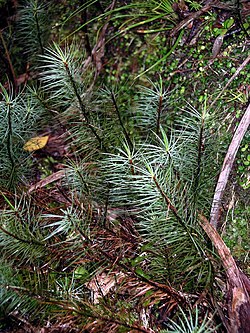| Dawsonia | |
|---|---|
 | |
| Dawsonia superba in Abel Tasman National Park, New Zealand | |
| Scientific classification | |
| Kingdom: | Plantae |
| Division: | Bryophyta |
| Class: | Polytrichopsida |
| Order: | Polytrichales |
| Family: | Polytrichaceae |
| Genus: | Dawsonia R.Br., 1811 [1] |
| Species | |
| |
Dawsonia is a genus of acrocarpous mosses. Dawsonia, along with other members of the order Polytrichales, are taller than most mosses and have thicker leaves. Their sporophytes have conducting systems analogous to those of vascular plants. Dawsonia superba is found in New Zealand, Australia and New Guinea. [2] D. longifolia is found in the Philippines, Indonesia, Malaysia, and Australia. [3] [4] [5] There is uncertainty as to whether D. superba and D. longifolia are actually distinct species.[ citation needed ]
